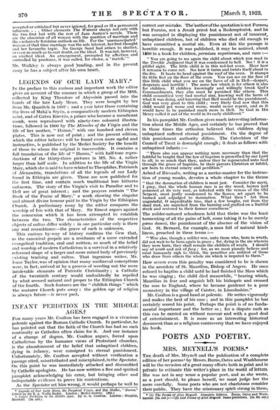LEGENDS OF OUR LADY MARY.*
IN the preface to this curious and important work the editor gives an account of the manner in which a group of the MSS. collected by King Theodore of Abyssinia passed into the hands of the late Lady Meux. They were bought by her from Mr. Quaritch in 1897 ; and a year later those containing the lives of Maba'a Ryon, a comparatively modern Ethiopian saint, and of Gabra Krestos, a prince who became a mendicant monk, were reproduced with ninety-two coloured illustra- tions, followed in 1900 by The Miracles of the Virgin and the life of her mother, " Hanna," with one hundred and eleven plates. This is now out of print ; and the present edition, which the editor believes will be found even more useful and instructive, is published by the Medici Society for the benefit of those to whom the original is inaccessible. It contains a full translation of the life of " Hanna," with half-tone repro- ductions of the thirty-three pictures in MS. No. 4, rather larger than half scale. In addition to the life of the Virgin Mary, which she is said to have related to Theophilus, Patriarch of Alexandria, translations of all the legends of our Lady found in Ethiopia arc given. These are now published for the first time, and contain much traditional lore hitherto unknown. The story of the Virgin's visit to Paradise and to Hell are of great interest ; and the prayers contain " The Book of the Praise of Mary," a work showing the singular and almost divine honour paid to the Virgin by the Ethiopian Church. A preliminary essay by the editor compares the worship of Isis with that of Mary. Sir Ernest argues against the connexion which it has been attempted to establish between the two. The characteristics of the respective objects of cultus differ widely : in one particular only is there any real resemblance—the grave of each is unknown.
This curious by-way of history confirms the i%ew that, as the canonical gospels are a residuum of a more extended evangelical tradition, oral and written, so much of the belief and worship of modern Catholicism is a survival in a relatively reformed shape of a larger and more mixed body of previously existing teaching and cultus. That ingenious writer, Mr. Isaac Taylor, was of opinion that many mediaeval conceptions were, in fact, arrived at by a process of weeding out the more intolerable elements of Patristic Christianity ; a Catholic of the twentieth century would undoubtedly be repelled by what seemed natural and proper to the Ethiopian Church of the fourth. Such features are the " childish things " which the maturer Church puts away : the golden age of religion is always future—is never past.










































 Previous page
Previous page